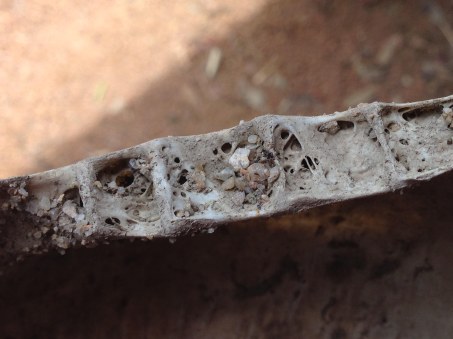
Before I got glasses for short-sight at the age of eleven, I used to wonder why people made such a fuss about birds. Most of them were invisible as far as I was concerned. The only ones I never had trouble seeing were the big ones: the egrets, the Wedge-Tailed Eagles, the black swans (which I’ve rarely seen since we’ve been back here) and, of course, pelicans (pelecanus conspicillatus).
We often see pelicans flying along the river, doing big circles to gain height. On the water, they glide through the big pools, loading up on carp, I hope, but probably on smaller fish, yabbies, or even lizards. A couple of months ago we often saw a group of three, but I don’t know if they were the same ones, or different each time. Presumably those are families, since they lay two eggs, but only rear one chick to adulthood. In the last few weeks, I’ve seen only solitary pelicans – possibly we’ve moved to the time of year where the grown-up fledgelings are sent off on their own.
Unlike the ones I’ve seen in big groups along the coast, our pelicans are very wary of people. I’ve never been able to get closer than a hundred metres. Since I still haven’t invested in a good camera with a zoom lens for taking bird pictures, my pelican photos continue to be distant and blurry, mostly including the flap of wings as they lift away, or pale tail feathers disappearing behind a small island, leaving only a few ripples or footprints on the sand. That’s an unimpressive set of traces for a bird that can have a wingspan of 2.6 metres (8.5 feet).
But if you have a visiting ornithologist you get other sorts of traces. Scott Edwards from Harvard University, after being cruelly misused for extreme weeding in our very steep 2011 plantation, picked up a bone from the sand by the river and recognized it as a pelican breastbone.

It’s an extraordinary thing, over forty-five centimetres (eighteen inches) long. Quite different from a chicken, the wish-bones I know well. Who knows what sort of wish you’d get from a pelican breastbone? I don’t plan to break it to find out.
The lightness due to the honeycomb texture is remarkable. I’d heard that bird bones were hollow, but I thought that meant tubes, not this spongy texture. Suddenly it doesn’t seem so amazing that a big bird like that can get off the ground.
Suddenly it doesn’t seem so amazing that a big bird like that can get off the ground.
This bone had obviously been lying in the sand for a long time. The ridged edge of the breast shield reminded me very much of the edge of a turtle shell we collected last Easter. I suppose both pieces have to link to others and lock together effectively. Evolution at work as usual.
For a beautiful description of a pelican encounter, I loved Paula Peeters’ blog on The Wisdom of Pelicans with her lovely illustrations.

That sounds like a really interesting book, Paula. I’ll have to look around for it too. Something I didn’t know until I started read John Pickrell’s “Flying Dinosaurs”, which I wrote about in my blog a while back, was that birds (and lots of dinosaurs as it turns out) have pneumatic bones. They breathe, in part, through their bones. That really blew me away!!
I don’t 100% understand how it works (I think I understood it better a year or so ago when I wrote the post!) but apparently its a part of a one way breathing system where a maximal amount of oxygen is available to enable the high intensity exercise of flying. The world is much stranger than you could ever imagine.
LikeLike
Wow! Breathing bones. Thanks for pointing it out.
LikeLike
Hey thanks for the beaut little post (I love your pelican pic with the arrow) and thanks for the citation :). If you haven’t yet seen it, and want to know more about bird bones, check out ‘The Unfeathered Bird’ by Katrina van Grouw – an amazing, beautifully illustrated book.
LikeLike
Indeed I don’t know “The Unfeathered Bird”. I’ll definitely look it up. My reading list is getting wider and wider as time goes on…
LikeLiked by 1 person